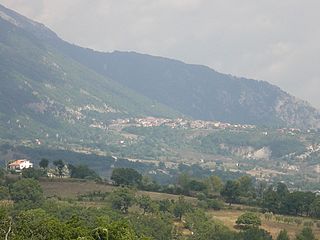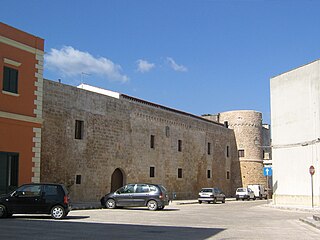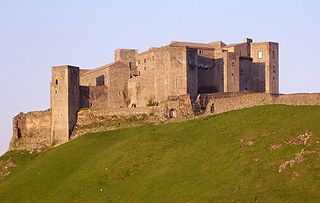This article needs additional citations for verification .(January 2014) |

Acaya is a small village, a community, in the province of Lecce and region of Apulia, in southern Italy.
This article needs additional citations for verification .(January 2014) |

Acaya is a small village, a community, in the province of Lecce and region of Apulia, in southern Italy.
The heart of the settlement is a good example of the few fortified villages left in Apulia,[ citation needed ] and its layout was planned to optimize defense and survival capabilities. The street pattern dates back at least to the 16th century and divides the village into rectangular insulae, or islands. The centre consists of six streets laid out in a regular pattern, parallel with each other and running roughly from north to south, all with a width of four meters, all but one some seventeen meters apart, and almost all having the same length. From east to west, three streets run at right-angles to the six north–south streets, one each at their south and north ends and one across the middle, making all of the streets orthogonal. The important buildings, such as the castle and the church, are built outside this grid of streets, the castle standing a little way off to the south-west.
The village lies some five kilometers from the Adriatic Sea and the Cesine public nature reserve (Riserva naturale statale Le Cesine).
40°20′N18°18′E / 40.333°N 18.300°E

Lonato del Garda is a town and comune in the province of Brescia, in Lombardy, northern Italy. Lonato is located about halfway between Milan and Venice, on the southwest shore of Lake Garda, the biggest lake in Italy.

Avezzano is a city and comune with a population of 40,785 inhabitants, situated in the Abruzzo region, province of L'Aquila, Italy. It is the second most populous municipality in the province and the sixth in the region. Avezzano was documented as an existing urban center in the ninth century. The city was destroyed by the earthquake of 1915. It was rebuilt after the 1944 Allied bombing. The city was decorated with the silver medal for civil merit, an award granted by the Italian Republic.

Andria is a city and comune (municipality) in the Apulia region of Southern Italy. It is an agricultural and service center, producing wine, olives and almonds. It is the fourth-largest municipality in the Apulia region and the largest municipality of the province of Barletta-Andria-Trani. It is known for the 13th-century Castel del Monte.

San Severo is a comune of c. 51,919 inhabitants in the province of Foggia, Apulia, Southern Italy. Rising on the foot of the spur of Gargano, San Severo adjoins the communes of Apricena in the north, Rignano Garganico and San Marco in Lamis in the east, Foggia and Lucera in the south, and Torremaggiore and San Paolo di Civitate in the west.
Gioia del Colle is a town and comune of the Metropolitan City of Bari, Apulia, southern Italy. The town is located on the Murge plateau at 360 metres (1,180 ft) above sea level, between the Adriatic and Ionian seas.

Senerchia is an Italian municipality with 1370 registered voters, but only 1036 inhabitants, in the Province of Avellino, located in the upper valley of the Sele River in Campania. It was the site of the defeat of Spartacus and is noted for the ruins of an ancient castle.

Bugnara is a comune and village in the province of L'Aquila in the Abruzzo region of southern Italy. It is one of I Borghi più belli d'Italia.
Salandra is a town and comune in the province of Matera, in the Southern Italian region of Basilicata.

Acquaviva delle Fonti is a town and comune of 20,446 inhabitants, in the Metropolitan City of Bari, in Apulia, Italy. Acquaviva is famous for its characteristic red onions, which have been awarded the DOP mark. The main monuments are the Palazzo de Mari, the Co-Cathedral of Sant'Eustachio and the ancient village. The town is located on the Murge plateau at an elevation of 300 metres (980 ft) above sea level, and is 26 kilometres (16 mi) from the Adriatic Sea and Bari, which is the biggest city of the region. The Ionian Sea is more than 45 kilometres (28 mi) to the south.

Casamassima is a town and comune of 19,786 inhabitants in the Metropolitan City of Bari, in Apulia, southern Italy. Is also called "The Blue Town". The town is located inland from the Italian coastline, thrives and is built on agriculture, primarily that of wine, olives and almond production. Founded around the seventh and eighth centuries, the village started as a Roman encampment, according to legend.
Carosino is a town and comune in the province of Taranto, in the northern Salento, part of the Apulia region of southeast Italy. Carosino was historically an Arbëreshë settlement. Its economy is based on the production of wine, olive oil and grapes.

Acquarica del Capo was a town and comune in the province of Lecce, Apulia, south-eastern Italy. In 2019 it was merged with the adjacent Presicce to form Presicce-Acquarica.
Vernole is a town and comune in the Italian province of Lecce in the Apulia region of south-east Italy.

Colletorto is a comune (municipality) of approximately 1,786 inhabitants in the province of Campobasso, in the Italian region of Molise, located about 45 kilometres (28 mi) from the capital of the region Campobasso and 40 kilometres (25 mi) from Termoli (CB), sea town with port, railway and highway A14.

San Menaio, also San Menaio Garganico, is a small village and seaside resort, a frazione of the comune of Vico del Gargano in the province of Foggia and the Apulia region of south-east Italy. The 2001 census counted a resident population of 193 living in 97 family units.

The Castle of Melfi in Basilicata is a monument owned by the Italian State and one of the most important medieval castles in Southern Italy. Its construction, at least the components still visible, dates back to the Norman conquest and has undergone significant changes over time, especially under the House of Anjou and the Crown of Aragon.

Marsiliana, known also as Marsiliana d'Albegna, is a village in Tuscany, central Italy, administratively a frazione of the comune of Manciano, province of Grosseto. At the time of the 2001 census its population amounted to 246.

Assergi is a frazione of the comune of L'Aquila, located about 11 km (6.8 mi) from the capital. With a population of just over 500, it is situated at an altitude of approximately 1,000 meters, below the western slope of the Gran Sasso in a small plain called the Piana di Assergi (Plain of Assergi). Assergi was formerly included in the comune of Camarda, which is directly to its south.

Altamura Castle was a castle located in the city of Altamura, now completely demolished. It was located over today's piazza Matteotti and a few remains of it are still visible inside the adjacent buildings, which were built partly with stones and structural elements from the castle. In a warehouse are an ogival arch and some stone coats of arms. A few other remains are found in the adjacent buildings, which were built in the 19th century.

The Visconti Castle of Jerago is a castle of Middle Age origin located in Jerago, Lombardy, Northern Italy. Having been a property of members of the Visconti house between the 13th and 18th centuries, it retains still today their memory in its name.